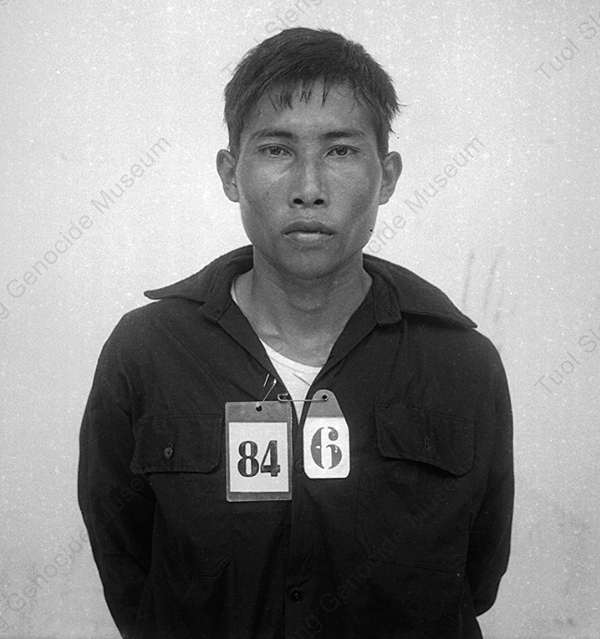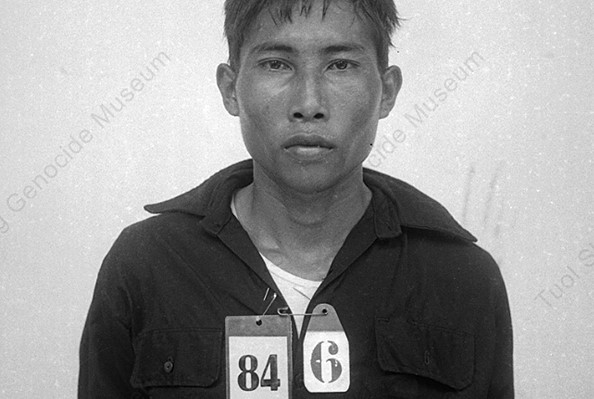Year Zero: Converting from VICE to Virtue
On April 9, 2021, VICE, the digital media and broadcasting company that touts itself as “the definitive guide to enlightening information,” published a ghastly interview with Matt Loughrey, a successful 42-year-old Irish photo restorer who developed a lucrative career colorizing historic photos. The article was titled, These People Were Arrested by the Khmer Rouge and Never Seen Again. It was subtitled, These portraits, recently colorized, humanize that tragedy. But that was all a lie. VICE and Loughrey’s efforts only “humanized” barbarism. In June of 2021 I stumbled upon this report quite by accident. Perhaps this essay can bring the story to a wider audience.
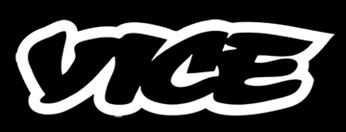
The VICE interview presented Loughrey’s colorized and digitally altered photos of prisoners held by the genocidal communist regime of Cambodia’s Khmer Rouge (Red Khmers), the radical Maoists who seized power and tormented the country from 1975 to 1979. Some two million Cambodians perished under the harsh rule of the Khmer Rouge; they died of preventable disease, starvation, torture, and a campaign of mass execution. As an artist, I have always felt unease concerning the colorization of historic black and white photos. That is because I also have a great interest in, and respect for history; attempts at rewriting history raises my ire. But what VICE and Loughrey did was outside the bounds of good judgement and decency.

Loughrey based his altered colorized portraits on actual black and white prison induction photos the communists took of their captives before locking them up in Security Prison 21. Also known as S-21, the prison was located in Cambodia’s capital of Phnom Penh.
Inside the prison starvation, interrogation, torture, and execution was the daily regimen. It held 20,000 prisoners, but only 7 left the building alive in 1979. There were 150 such camps across Cambodia, though Security Prison 21 was certainly the largest.
S-21 was not a mass execution center per se. When masses of detainees were marked for liquidation, they were trucked to Choeung Ek, a large “killing field” outside of Phnom Penh. Still, hundreds of innocent victims were dumped into unmarked graves on the grounds of S-21.
When the Khmer Rouge government was driven from power in 1979 by an invasion of the army of Vietnam, the S-21 death camp was transformed into the Tuol Sleng Genocide Museum. It continues to maintain an extensive archival collection documenting the genocide conducted by the Khmer Rouge. Part of that collection includes the S-21 prisoner photographs and the forced confessions detainees made under torture.
In his VICE interview Loughrey made the dubious claim that he colorized three S-21 photos for “a person in Cambodia” that had contacted him with the request; Loughrey offered no verification of such an appeal. VICE indicated that once Loughrey saw the size of the Tuol Sleng Genocide Museum photo archives, he decided to download and colorize even more images from the online source. In the interview he was quoted as saying: “The more I looked into it and the more images I saw, I thought, well, this has to be done.” VICE did not report he did so without permission from the museum. It is unknown how many images he filched.
Making things worse, and this is key, Loughrey went far beyond colorizing the photos, he changed the entire facial expressions of the prisoners by digitally painting smiles on their faces! The corners of their mouths curved upwards showing smile lines, their eyes were brightened, their cheeks were glowing. From their faux beaming smiles the prisoners looked as if they were attending a festive occasion rather than being shoved into a death camp. While VICE published Loughrey’ altered smiling photos, they did not publish the original photographs.

Without institutional backing, Loughrey colorized photos he lifted from the Tuol Sleng Genocide Museum website. That alone was a violation of the museum’s terms and conditions, which states its historic images must never be altered or modified. But painting smiles on the faces of innocent people who were tortured before they were executed… that is hard to fathom.
One reason for Loughrey’s chilly indifference as an “artist” is that, consciously or not, he is part of the postmodern art world, where spectacle and shock carry more weight than substance, and truth is just a social construct. His insensitivity reflects postmodern art stars like Jake and Dinos Chapman, who once clothed ghoulish Nazi mannequins in SS uniforms, replacing their swastika armbands with smiley faces, and exhibited the entire mess at the White Cube gallery in London. Loughrey’s act of painting smiles on the faces of Khmer Rouge victims was pure Chapman brothers—though liberal art institutions will likely receive Loughrey less favorably than they did the “brilliant” Jake and Dinos.
Loughrey’s postmodernist ethics are evident in his obsession with “restoring” historic black and white photographs by way of colorization. He has made a career out of “re-imagining” the past. As a visual artist who has intentionally created many artworks in glorious black and white, I would hate to see a technician in the future colorize my works. Likewise, when I view a photo of Paris taken by Louis Daguerre in 1830, I want to see the world as he and his colleagues saw it. I do not want his vision to be “restored” or “re-imagined.” Colorizing Daguerre’s unique photos would be a crime against art and history.
Imagine the outrage if someone painted smiley faces on the photos of those who died in Nazi extermination camps like Auschwitz. In point of fact, Loughrey did something very close to that, provoking an angry response from the Auschwitz Museum (you will find the details if you continue reading). Most importantly, Loughrey and VICE committed an affront against the dignity of all Cambodian people, an abusive blow equal to a racist attack. The oh so progressive VICE did this, and it should never be forgotten.

The unaltered, black and white prisoner photos from S-21 are haunting. Looking through those photos archived online by the Tuol Sleng Genocide Museum, one young woman caught my eye. She is unidentified. Museum records state only that she was held in cell number 16 (indicated by the tags on her blouse), and that she was prisoner 3,753 (hand written on the photo by a Khmer Rouge guard). Aside from the fact that she died, everything else about her is a mystery.
It is difficult to interpret her expression; to me the young women looks as if she had seen too much evil and it no longer fazed her. That, or it was the demeanor of a woman who knew she was doomed. Before I discovered that Matt Loughrey had transformed Prisoner 3,753 into a gussied-up glamour doll, I chose to use the original unaltered photo to illustrate my essay. The altered photo reminds me of a lyric from a 1981 song by UK punk band, Crass: “Like a glamour billboard in a battlefield. At least the bloody-red poppy was of nature’s will.” Out of respect for the deceased, I will not post that altered colorized abomination to my article.
After VICE published Loughrey’s photos on April 9, 2021, Cambodian nationals and those in diaspora began to inveigh against the cruel racist provocation. April 10, 2021, the National Cambodian Heritage Museum and Killing Fields Memorial in Chicago, Illinois, issued a statement that read in part: “We do not endorse those that seek to profit and benefit from the violent and lived traumas of our past and current history. Minimizing the pain and trauma of our community from those who are not connected to the experience is not only revising and erasing history, it’s a violent act.”
On April 11, 2021, Cambodia’s Ministry of Culture and Fine Arts (MCFA) located in Phnom Penh, Kingdom of Cambodia, issued a statement that read in part: “MCFA does not accept this kind of manipulation, and considers this work of Matt Loughrey to seriously affect the dignity of the victims, the reality of Cambodia’s history, and in violation of the rights of the Museum as the lawful owners and custodians of these photographs.”

On April 16, 2021, the Auschwitz Museum located on the grounds of the former Nazi concentration camp in Poland, tweeted a message of solidarity with the Tuol Sleng Genocide Museum. In that dispatch the Auschwitz Museum made known they had contacted Matt Loughrey and asked him to remove from his Instagram account, a color animation he created of Czesława Kwoka. He refused. Kwoka was a 14-year-old girl who died in Auschwitz on March 12, 1943. She was a Polish Catholic and one of the approximately 230,000 children the Nazis sent to the camp for extermination. Only around 650 children survived Auschwitz.
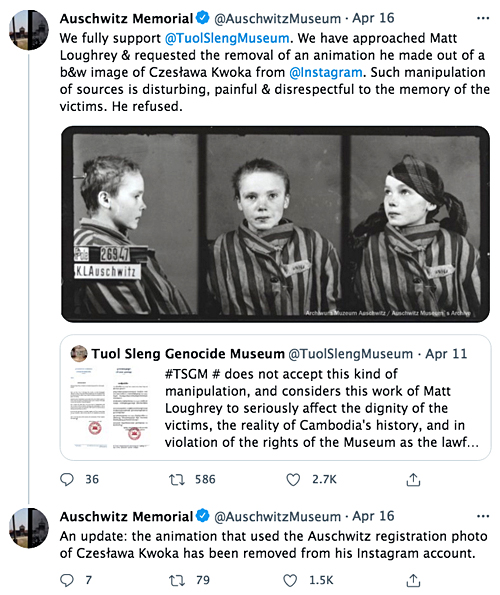
Not surprisingly, without permission Matt Loughrey made his animation of Kwoka with images owned by the Auschwitz Museum. He used an imaging technique he developed called X-Oculi, arrogantly describing it as “a combination of unrivaled artistry and cutting edge orbital motion-tracking.” After refusing the reasonable request of the Auschwitz Museum, the pretentious Loughrey no doubt received a tidal wave of negative criticism. On April 16, 2021, the offending animation was taken down from Instagram without comment or fanfare.
A petition demanding that Matt Loughrey apologize “for the theft, manipulation and appropriation of these photographs,” and that VICE apologize for “publication and support of Matt Loughrey’s work” was initiated by Dany Pen and 7 other Cambodians. Pen lost her family members at the S-21 death camp, she had biting words for VICE:
“I strongly implore VICE to take down these photos that are promoting white supremacy, cultural appropriation, cultural erasure, and victim dismissal. It promotes harm and brings on psychological and emotional violence towards my Cambodian community.”
It is troubling that our time has produced characters like Matt Loughrey, as well as sensationalist rags like VICE. Loughrey’s website touts his “ambitious photo colorization project” as “an option for museums and libraries to upgrade and re-imagine their own visitor experiences.” With no sense of irony his website bears a masthead reading “Bridging a gap between history & art.” He dared to write, “we find ourselves in an age of image obsolescence,” and that his digital skills are “a form of visual defense against this.” He spouted even more rubbish with, “collections are being rescued, detail and character that could never be seen in the original images is being uncovered.” All while the ne’er-do-well erased history and painted a happy face on genocide.
Loughrey’s website makes no mention of insulting and hurting the Cambodian people. He does however brag that “current and previous clients include: DELL, 21st Century Fox, National Parks Service, BBC, ABC Australia, The New York Post, The Guardian, The Times, National Geographic and more.” If they had any principles these supporting companies would wash their hands of Loughrey. He should delete his websites and slink away, hoping no one will recall his depravity.
On April 11, 2021, the “editorial leadership” of VICE issued a short and confused statement that they were taking down the Loughrey photos and interview. Saying the photos were “manipulated beyond colorization” and the “story did not meet the editorial standards of VICE,” they called publishing the materials an “error.” VICE did not have an editor informed enough to realize at first glance that the photos were drastically altered. If the interview and photos did not meet the lofty editorial standards of VICE why publish them in the first place? The genocide committed by the Khmer Rouge remains a historically earth shaking story, but the vacant millennials running the show at VICE have blank memories. The remarks from VICE “leadership” is an admission the company has absolutely failed as a legitimate news organization. On April 16, 2021, they released an updated statement that was closer to an apology—but still worthless. I have entirely lost my patience with poseurs who feign humanitarianism.
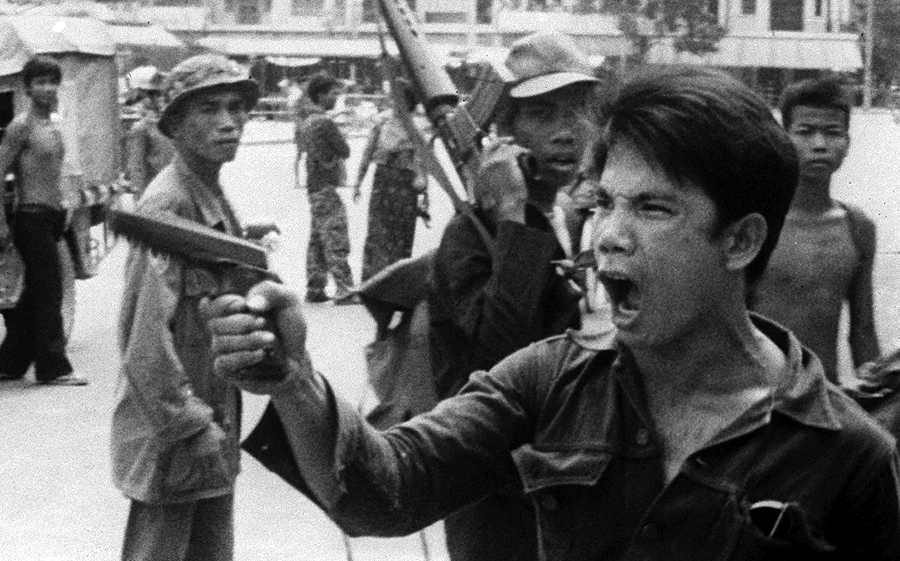
I was 21-years-old when the Khmer Rouge seized Cambodia’s capital of Phnom Penh on the morning of April 17, 1975. That same day they ordered the complete evacuation of Phnom Penh and other cities. By force of arms they marched everyone into the countryside to undertake the building of an agrarian utopia. In doing so they closed schools, factories, and hospitals; the sick and infirmed were forced to march, so too children and the elderly—thousands died along the way as food, water, and medical care were not provided. At the time, reports coming out of Phnom Penh were unsettling. When I saw the photo of a Khmer Rouge soldier pointing his 1911 pistol at shop owners, demanding they abandon their businesses and leave the city, I knew Cambodia was doomed. Because of the Vietnam war, I had been following politics in Southeast Asia since the mid-60s as an idealistic pre-Teen, so I knew of the Khmer Rouge. But they were about to give me, and the world, a lesson in medievalist savagery.
The leader of the Khmer Rouge, Pol Pot, who was referred to as “Brother Number One,” declared the communist takeover to be “Year Zero,” the beginning of an era when all vestiges of the past would be destroyed. Straight away, all money, banking, private property, and religions were abolished. The liquidation of the regime’s enemies started. Anyone who represented the past—educated middle-class professionals, technicians, artists, writers, filmmakers, musicians, were all exterminated. Wearing eyeglasses or speaking a foreign language could identify a person as an intellectual to be executed. Everyone in Year Zero Cambodia was forced to wear Khmer black pajamas and the traditional red and white gingham Krama scarf. To do otherwise was dangerous.
The “Marxists” of the Khmer Rouge envisioned the country’s peasants building communism through collective labor and people’s communes. They applied Mao Zedong’s “Great Leap Forward” and “Cultural Revolution” to their nation. In fact the Chinese Communist Party backed the Khmer Rouge, giving them political support and endless military supplies. But the Red Khmers also viewed the ancient 12th century Angkor Empire of Cambodia as an agrarian utopia to be replicated. They called their nation “Kampuchea,” using the Khmer pronunciation of Cambodia. They referred to their leaders as “The Angkar” (The Organization). And on Jan. 5, 1976, they presented the official red flag of “Democratic Kampuchea,” which incorporated a stylized Angkor Wat symbol in yellow. The Khmer Rouge were nothing if not ethnic and national supremacists.
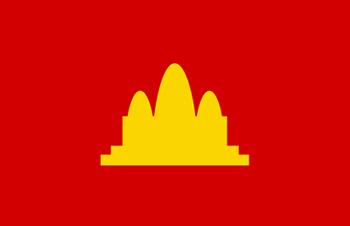
Once taking power the intolerant Khmer Rouge began to annihilate 1000s of ethnic Vietnamese, Thai, Chinese, and Cham people. Condemning religion as “detrimental,” the Khmer Rouge targeted Christians, Catholics, Muslims, and Buddhists for extermination.
In 1975 they destroyed the Roman Catholic Cathedral of Phnom Penh, taking it apart stone by stone until there was nothing left. It was one of 73 Catholic churches destroyed in Year Zero.
In 1975 there were 66,000 Buddhist monks and 4,000 Buddhist temples. Before the Khmer Rouge were driven from power, they murdered more than 25,000 monks and obliterated 1,968 temples.
Two reporters were working together in Phnom Penh when the Khmer Rouge surrounded the capital—Cambodian photojournalist and interpreter Dith Pran (1942-2008), and NYTimes reporter Sydney Schanberg (1934-2016). Schanberg was one of the last Western journalists to stay in the city. The two witnessed the communist army take the city. In his last dispatch Schanberg wrote: “Most of the soldiers are teenagers. They are universally grim, robot-like, brutal. Weapons drip from them like fruit from trees… grenades, pistols, rifles, rockets.”
The Khmer Rouge wasted no time in unleashing large scale looting and executions. The two reporters were captured by guerrillas Schanberg described as “maniacal.” The two were threatened with death, and only the pleas of Pran saved them from being executed in the street. They took refuge in the French embassy compound along with a throng of desperate foreigners. Being Cambodian Pran was dragged from the embassy by the Khmer Rouge and marched into the countryside; they expelled Schanberg and the other Westerners from the embassy and trucked them to Thailand. As Schanberg noted: “With this act, Cambodia was sealed. The world could not look in. The killing could begin.”
The perilous journey of Dith Pran had just begun. He ended up in a Khmer Rouge work camp as a slave laborer—all for the good of the new “Democratic Kampuchea.” His captors fed him a tablespoon of rice a day, he supplemented his ration with an occasional beetle or small lizard he would secretly catch. He experienced beatings, torture, starvation, and witnessed endless executions. Pran endured four years of this, and when Vietnam overthrew the Khmer Rouge in 1979 he broke out of the camp and escaped over the Thai border. His 60 mile flight to freedom had him slogging through muddy fields filled with decomposing human corpses. These were the execution grounds where the Khmer Rouge slaughtered over a million people. Pran dubbed them the “killing fields.”
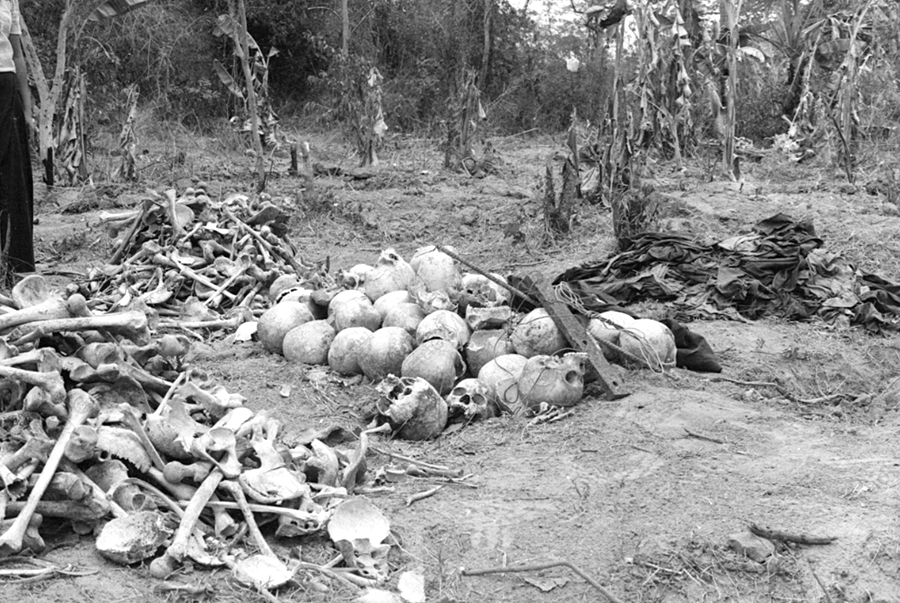
Today the Choeung Ek Genocidal Center stands outside Phnom Penh, it is built on one of the largest Khmer Rouge killing fields. Once an orchard before it was turned into a death camp, there are 129 mass graves in Choeung Ek. Heavy rains still uncover human teeth, bone fragments, and bits of clothing. A Buddhist “stupa” monument commemorating the dead stands in the middle of the killing field. Its plexiglass walls are filled with more than 8,000 skulls found onsite. Many of the skulls show evidence of having been bashed. To save ammunition the Khmer Rouge made victims kneel at the edge of a large pit, then clubbed their heads with steel bars or agricultural hoes; victims fell into the mass grave.
A “killing tree” is also found at Choeung Ek. Whole families were murdered at the camp, including babies. Khmer Rouge guards held toddlers by the ankles, then swung their heads into the tree. The tiny smashed bodies were tossed into a nearby open pit. Despite the communist aim of totally eradicating Buddhist “leeches and worms,” today the tree is covered in Buddhist string bracelets left by visitors as spiritual gifts to the slain little ones.
In 1980 Sydney Schanberg published his book The Death and Life of Dith Pran. The book served as the basis for the 1984 movie The Killing Fields, which depicted the agonies of Cambodia as seen through the experiences of Dith Pran and Sydney Schanberg. The book and the film brought international attention to the tragedy that had befallen Cambodia. If VICE really wanted to “restore” the history of Cambodia and “humanize” the tragedy, they would have recited the tale of Dith Pran to an audience completely unfamiliar with his saga. Instead, VICE published the vulgarities of braggart Matt Loughrey.

Cambodians were not the only ones tortured and murdered at the S-21 death camp. In 1978 the Khmer Rouge “navy” captured two hapless young Americans who were sailing off the coast of Cambodia. Michael Deeds and Chris Delance were sent to S-21 where they were tortured for 40 days. The Khmer Rouge were sadistic torturers who employed a variety of techniques in their “interrogations.” They forced prisoners to eat human feces, ripped out fingernails, burned detainees with hot wires or cigarettes, used electric shock, pushed needles under fingernails, administered beatings with sticks or electric wire, used water-boarding and other methods of drowning detainees, and covered victims with centipedes and scorpions.
Michael Deeds and Chris Delance were tortured until they signed “confessions” that they were CIA agents. The commander of S-21 was Kaing Guek Eav, aka “Duch.” After the fall of the Khmer Rouge, Duch testified at his trial that he was given orders by Pol Pot’s right hand man to “destroy all human beings from S-21” before the army of Vietnam arrived. That included Americans Deeds and Delance. They were bound, wrapped in gasoline soaked tires, and set on fire. They were gruesomely executed two days before Vietnamese soldiers liberated the camp. The Vietnamese discovered the prison by following the stench of the many burned bodies left to rot and decompose in the tropical heat. Perhaps Matt Loughrey will digitally paint the two Americans with happy smiling faces.
It is an irony that Cambodian artist Vann Nath (1946-2011) occupied the cell next to where Michael Deeds was locked up. The artist was one of 7 detainees who survived Security Prison 21. Prior to 1975 he made a living painting landscapes and film posters, but in 1977 he ran afoul of the Khmer Rouge and they put him in S-21. Every evening Vann Nath would watch guards pull Deeds from his cell, dragging him elsewhere for “interrogation.” The artist would see the guards return hours later to dump their tortured victim into his cell, where he would forlornly sing to himself. Today, the paintings of Vann Nath are permanently displayed at the Tuol Sleng Genocide Museum. Each a depiction of unspeakable brutality, each a condemnation of tyranny. VICE never did a story about Vann Nath, no, they chose to interview the no account Matt Loughrey.
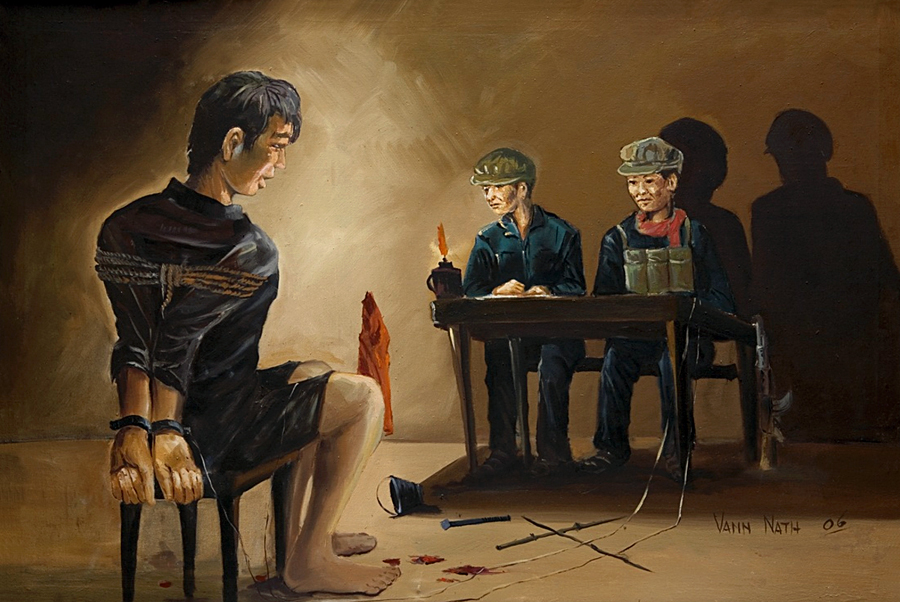
In the end, the excesses of the Khmer Rouge sealed their fate. Their xenophobic hatred of ethnic Vietnamese—who settled in Cambodia long ago, caused the Khmer Rouge to massacre them by the thousands. By 1977 the Khmer Rouge were crossing into Vietnam with troops and artillery to attack Vietnamese towns and villages. The last straw came when a large force of heavily armed Khmer Rouge marched four miles into Vietnam and slaughtered over 3,000 Vietnamese civilians in the Ba Chúc massacre on April 18, 1978. On Dec. 25, 1978, Vietnam launched the invasion of “Democratic Kampuchea,” rapidly crushing the lion’s share of Khmer Rouge fighters and overthrowing the Pol Pot regime. On Jan. 7, 1979 Vietnam rolled into Phnom Penh, effectively putting an end to the genocide.
Remnant Khmer Rouge dead enders retreated to jungle enclaves near the Thai border and continued their fight (which of course was backed by Communist China). In 1998 a Khmer Rouge officer put the ailing Pol Pot under house arrest, but Brother Number One died that same year. In 2006 the Cambodian government and the UN established the “Khmer Rouge Tribunal,” where the remaining three Khmer Rouge leaders were tried and sentenced. In 2012 Duch was jailed for life for having run the S-21 death camp. In 2014 Nuon Chea (Brother Number Two) and Khieu Samphan (Khmer Rouge head of state) were sentenced to life for crimes against humanity for their roles in the Year Zero forced evacuations. In 2018 Chea and Samphan were found guilty of genocide for the mass extermination of Vietnamese Cambodians.
VICE supposedly captured the millennial focused market in 2015 with its “alternative” approach to news. Needless to say, I always perceived VICE as just another corporate media platform to be avoided. Now, with their self-inflicted Khmer Rouge wound destroying their carefully constructed “progressive” image, my viewpoint has been vindicated. As for VICE being “the definitive guide to enlightening information,” that pretense was destroyed in a Year Zero of their own making. It is long overdue that journalists convert from a life of vice, to a life of virtue. After all, dictionaries define “vice” as a “wicked, immoral, corrupt, and depraved” practice.
